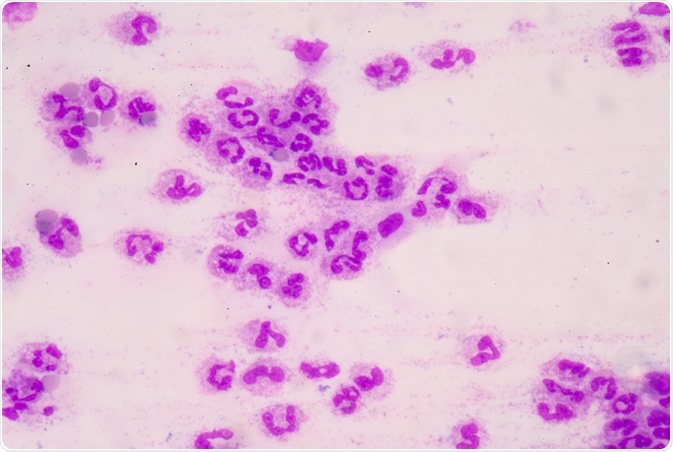A team from the Centro Universitário UNA in Brazil has developed a sickness behavior score (SBS) that implements several physiological variables to determine the severity of sepsis and mortality. Evaluation of the murine animal model evaluated six indicators of sickness behavior: change in temperature, sucrose or water preference, food intake, liquid intake, body weight, and movement.
 Image Credits: Schira / Shutterstock.com
Image Credits: Schira / Shutterstock.com
To determine SBS, the team evaluated the induction of sepsis using cecal ligation and puncture (CLP) or laparotomy only (as a sham surgery). To determine the degree of neuroinflammation, markers of IL-6, oxidative stress, and HPA axis activation were determined. Septic rats scored higher than their sham counterparts on the SBS, and SBS was found to correlate negatively with cognitive ability, as indicated by four cognitive-behavioral tests taken 8 days after surgery.
The severity and/or mortality of several human illnesses can be assessed by a scoring system. Several currently exist and include SOFA (Sequential Organ Failure Assessment) and APACHE (Acute Physiology, Age, Chronic Health Evaluation). The development of analogous scoring systems is currently under study for animal models. This is particularly useful as an animal model is limited; possessing lower blood volume, blood collection difficulty, and lack of equipment for organ failure determination. The use of a scoring system presents an easier way to evaluate the severity of sepsis in animals.
Behavioral and physiological alterations can also be assessed using a scoring system. The work by the team at the Centro Universitário UNA builds on existing work which has developed a clinical score for sepsis that is based on clinical changes across variables.
These are limited as they may be induced by external influence, rather than stress and require researchers to be trained. Physiological changes, however, are more relevant indicators of the central nervous system impairments; as such, de Souza Goldim and colleagues suggest a sickness behavior score that uses physiological variables to assess the severity of sepsis and mortality.
To develop a robust SBS, the team used rats as animal models. These were subject to sepsis induction by a procedure called cecal ligation. This procedure results in the emptying of fecal material into the peritoneal cavity, which generates an immune response due to the introduction of micro-organisms into the system.
The animals were evaluated daily and assessed on five sickness behaviors (anhedonia, hypothermia, adipsia, lethargy, and anorexia). These were evaluated using several behaviors of the rats. The measurement of the liquid intake was used as a measure of adipsia; anhedonia was evaluated by sucrose or water preference; hypothermia was measured via changes in body temperature; anorexia by measurement of daily food intake and lethargy by behaviors in the cage (exploration, the movement toward experimenter, and strength while grasping).
The team found that the change in body temperature was correlated with the progression of sepsis and mortality. Reduced food consumption persisted in CLP induced sepsis models. Symptoms of anhedonia, as demonstrated by the preference for water over sucrose, and adipsia, persisted for CLP treated models relative to their sham controls.
In the murine model, severe sepsis was found to be correlated with hypothermia; specifically, the length of hypothermia, which was in turn, modulated by the size of the puncture. CLP treated models presented lethargy for three of the 8 days of study. These findings supported the use of these parameters as indicators of sepsis.
SBS was also found to be correlated with mortality; survival rates of 70% were observed in CLP treated group relative to 100% in the sham group. Similarly, SBS was associated with the blood-brain barrier (BBB) permeability and inflammation markers such as IL-6. This pro-inflammatory cytokine is strongly correlated with sepsis. The loss of integrity in the BBB results from systemic inflammation as a result of persistent endotoxin LPS and proinflammatory cytokines.
This leads to the activation of the endothelium, which augments local inflammation. Additionally, the endothelial production of matrix metalloproteinases (MMPs) causes a disruption of protein cell junction alterations which result in the breakdown of the BBB.
Acute SBS was correlated with activation of the HPA axis and inflammation markers; chronic SBS, however, was correlated with oxidative stress, inflammation markers, brain-derived neurotrophic factor (BDNF) and depressive behavior.
The scoring system presented by the group represents a reliable and reproducible means of indicating sickness behavior. This is the first system based on physiological parameters and included a prolonged period of assessment (8 days). This supersedes previous assessments that have only studied animal models for up to 5 days post sepsis induction.
The scoring system offers an advantage relative to those currently used; a global analysis of sickness behavior can be determined through the evaluation of several parameters, rather than relying on a singular indicator.
Funding
This study was financed in part by the Coordenação de Aperfeiçoamento de Pessoal de Nível Superior - Brasil (CAPES)
Source
de Souza Goldim et al. (2020) Sickness Behavior Score Is Associated with Neuroinflammation and Late Behavioral Changes in Polymicrobial Sepsis Animal Model. Inflammation. doi: https://doi.org/10.1007/s10753-020-01187-z
Further Reading